Low ceilings can really make a room feel cramped and boxed in. But honestly, you’d be surprised at how a few clever design moves can trick the eye and make ceilings seem much higher than they are.
Remember to repin your favorite images!
Just painting your ceiling a lighter color than your walls does wonders. This simple switch draws your gaze upward, opening up the space and making everything feel a bit more expansive.
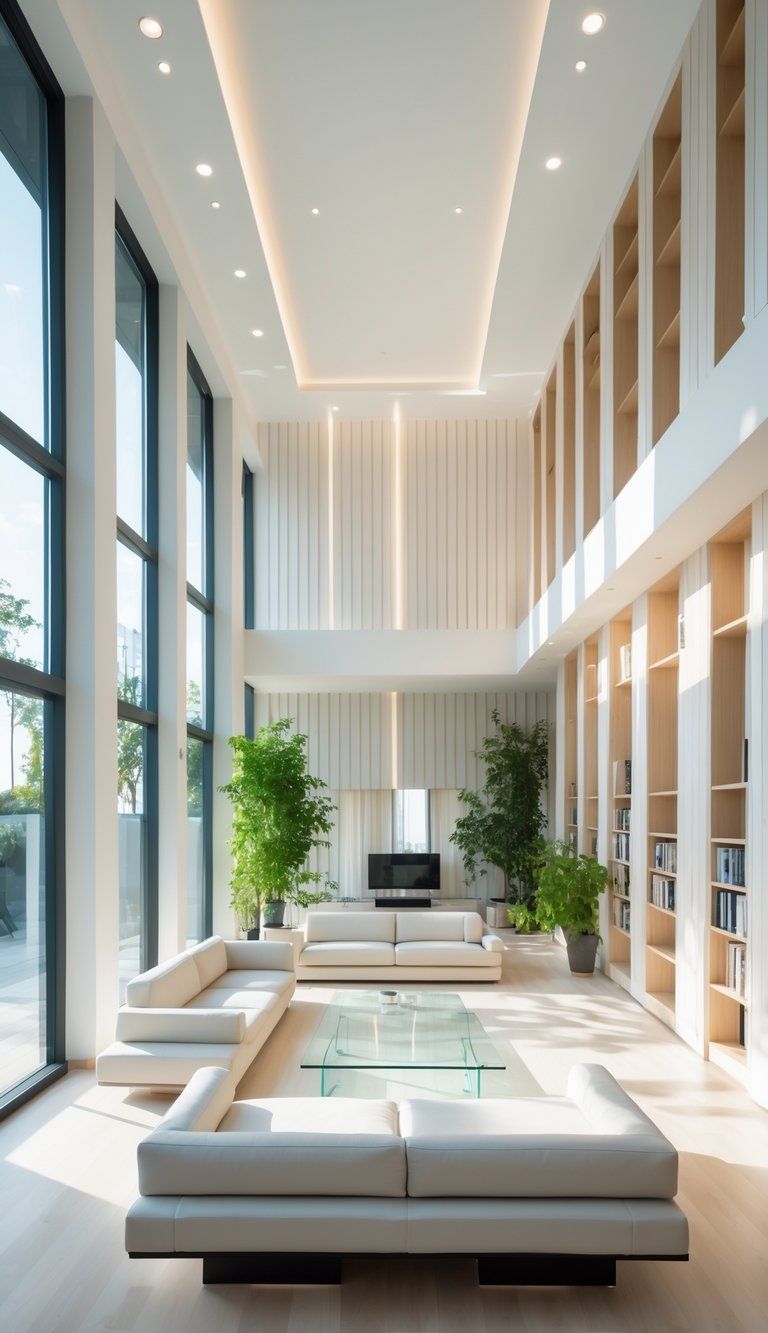
Furniture makes a big difference too. When you pick low-profile pieces, you get more space between the furniture and the ceiling—so it all feels taller.
Sleek sofas, beds closer to the floor, and short coffee tables all help. These choices make the room feel like it has a lot more height than it actually does.
Lighting and curtains can change everything as well. Floor-to-ceiling curtains pull your eyes up, while the right lighting can brighten the ceiling and open up the space.
Mirrors bounce light around and add depth. Suddenly, that low ceiling doesn’t feel so low anymore.
Understanding Low Ceilings and Perceived Height
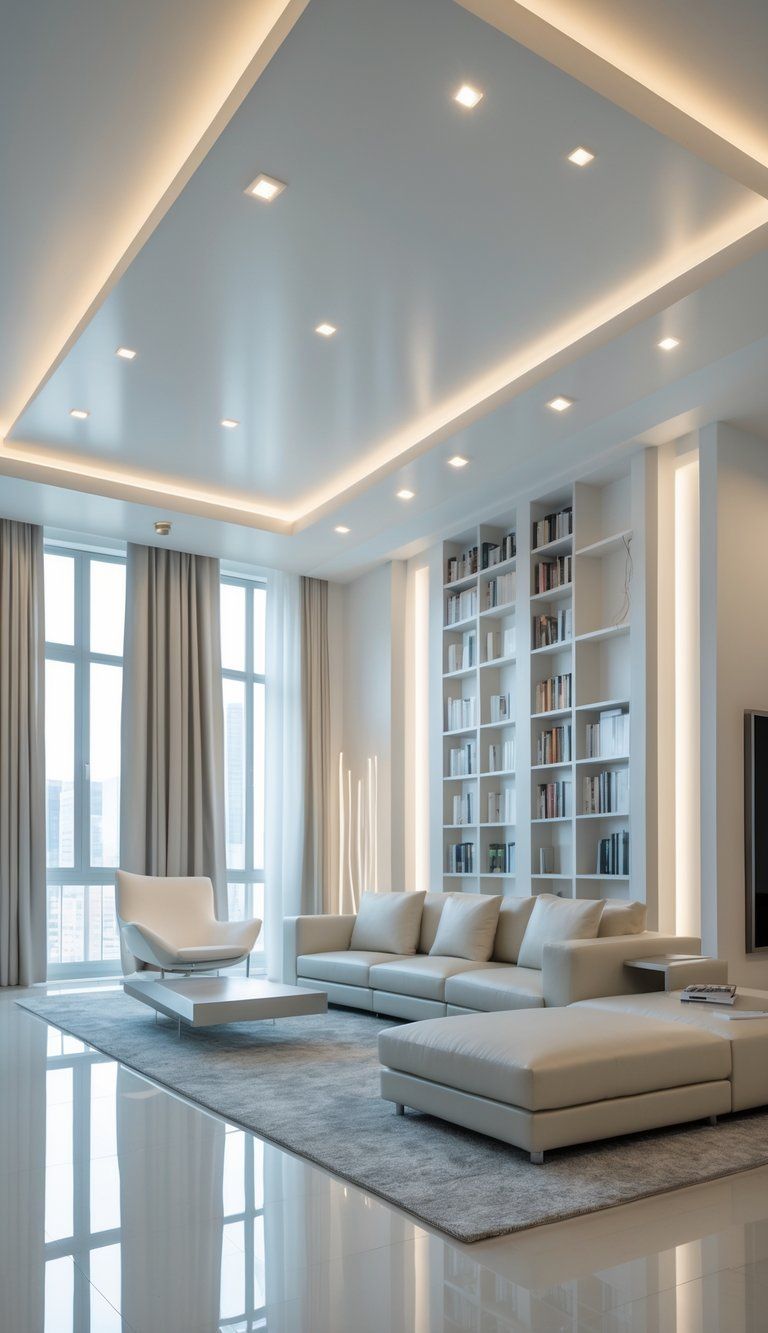
Low ceilings can change how you experience a room. But if you understand what affects your sense of height, you can totally transform even the smallest spaces.
What Defines a Low Ceiling
A low ceiling usually means anything 8 feet or less from floor to ceiling. In homes built before the 1950s, 7-foot ceilings were pretty normal—mostly because of heating costs and the materials available back then.
Modern building codes now require at least a 7-foot ceiling for rooms you actually live in. Most new homes go for 8 or even 9 feet these days.
Basements, attics, and converted spaces often end up with lower ceilings just because of the structure. Some designers even choose lower ceilings on purpose, especially for cozy spots like dens or reading nooks.
How “low” a ceiling feels also depends on the room’s shape. A narrow room with an 8-foot ceiling feels a lot more cramped than a wide one with the same height.
The Science Behind the Illusion of Height
Your brain relies on visual cues and optical tricks to judge space. That’s why certain design moves can make a room look much taller than it really is.
The eye naturally follows lines and patterns. Anything vertical pulls your gaze up, so vertical stripes or tall, skinny furniture help a lot.
Light is a big deal too. Bright rooms feel bigger because light bounces around and expands the space. Dark ceilings soak up light and feel like they’re pressing down, but lighter ceilings seem to float away.
Contrast matters as well. When your eye has to travel farther from floor to ceiling, the space in between feels larger. Placing décor at different heights creates this visual “journey.”
Psychological Impact of Ceiling Height
Ceiling height isn’t just about looks—it actually affects how you feel and think.
Researchers at the University of Minnesota found that higher ceilings encourage creative, big-picture thinking, while lower ceilings help you focus on details and tasks. That’s probably why libraries have high ceilings and cozy restaurants keep things lower.
Done right, low ceilings can feel safe and snug—perfect for relaxing or having a quiet conversation. But if you design them poorly, they might make you feel boxed in.
Culture plays a part too. Some cultures love the intimacy of lower ceilings, while others see tall ceilings as a sign of freedom or even status.
Finding the right balance is key. Even with low ceilings, you can use visual tricks to avoid that cramped feeling and still keep things cozy.
Strategic Use of Lighting to Open Up Low Ceilings
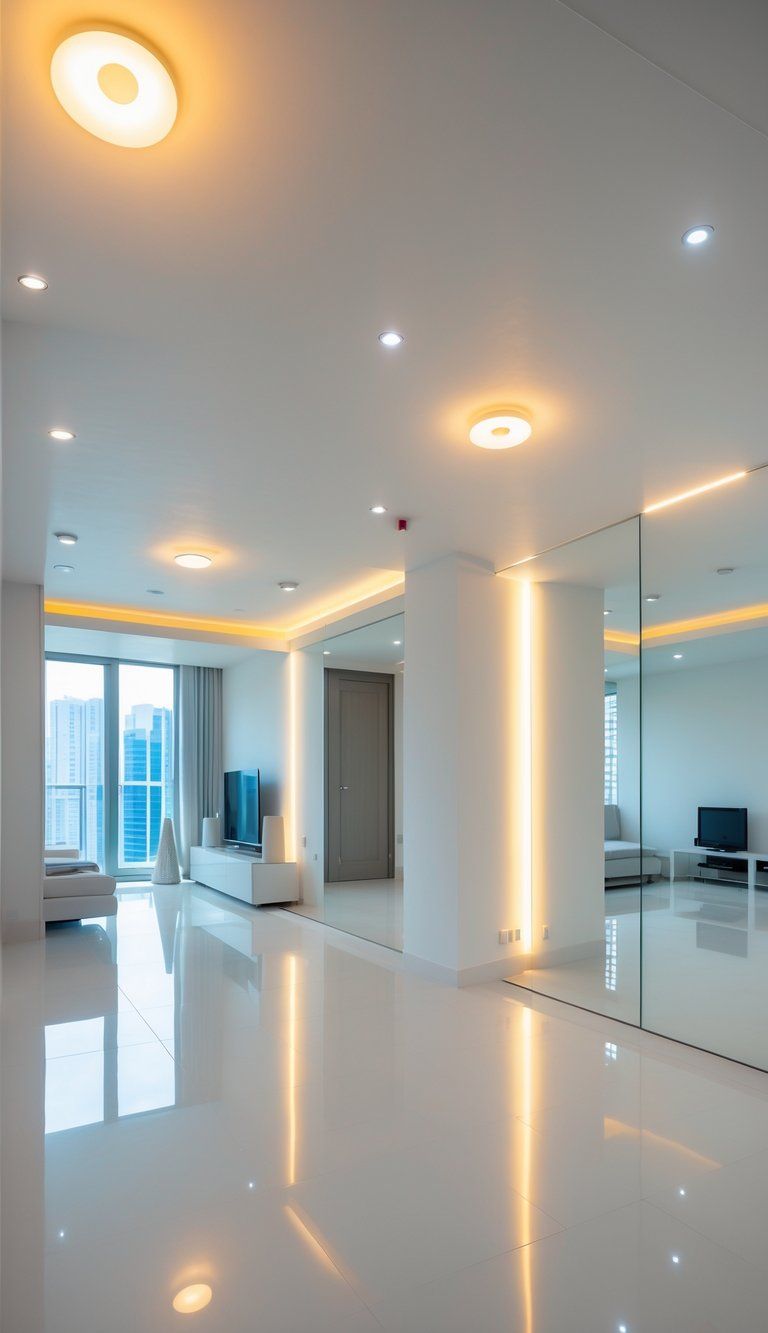
Lighting can completely change how tall a room feels. The right fixtures and placement will draw your eyes up and make the whole space feel lighter and more open.
Advantages of Recessed Lighting
Recessed lights work great for low ceilings. They sit flush with the ceiling, so you don’t lose any headroom.
Pick small-diameter fixtures—4 inches or less—so they stay subtle. Space them evenly around the room’s edge to wash the walls with light and create a vertical effect.
Highlighting architectural features or artwork up high with recessed lights will naturally pull your gaze upward.
Dimmable recessed lights let you control the mood and brightness. The brighter the room, the more open it feels, so having that flexibility is a win.
Optimal Placement of Wall Sconces
Wall sconces create vertical light trails that make ceilings look higher. Try mounting them about three-quarters up the wall—higher than you might expect.
Choose sconces that shine upward. This up-lighting creates shadows and highlights that trick your brain into seeing extra height.
Pairing sconces with mirrors doubles the effect. The light bounces around and makes the room feel bigger.
In narrow hallways, alternate sconces on each side. This arrangement keeps things from feeling like a tunnel.
Selecting Light Fixtures for Vertical Emphasis
When you pick pendant lights or chandeliers, go for slim, vertical designs instead of wide ones. Clear glass and slender shapes take up less visual space.
Look for fixtures that shine light both up and down. This creates more visual interest and lights up both the ceiling and the floor.
Track lighting with adjustable heads can aim light upward. That lets you highlight different spots and keeps the focus on height.
Metallic or reflective fixtures—chrome, brass, glass—bounce light everywhere. That extra reflection helps the room feel more open.
Mix up your lighting. Use recessed lights, wall sconces, and a pendant or two for depth and dimension. Suddenly, the ceiling feels a lot less noticeable.
Color Techniques to Elevate Your Space
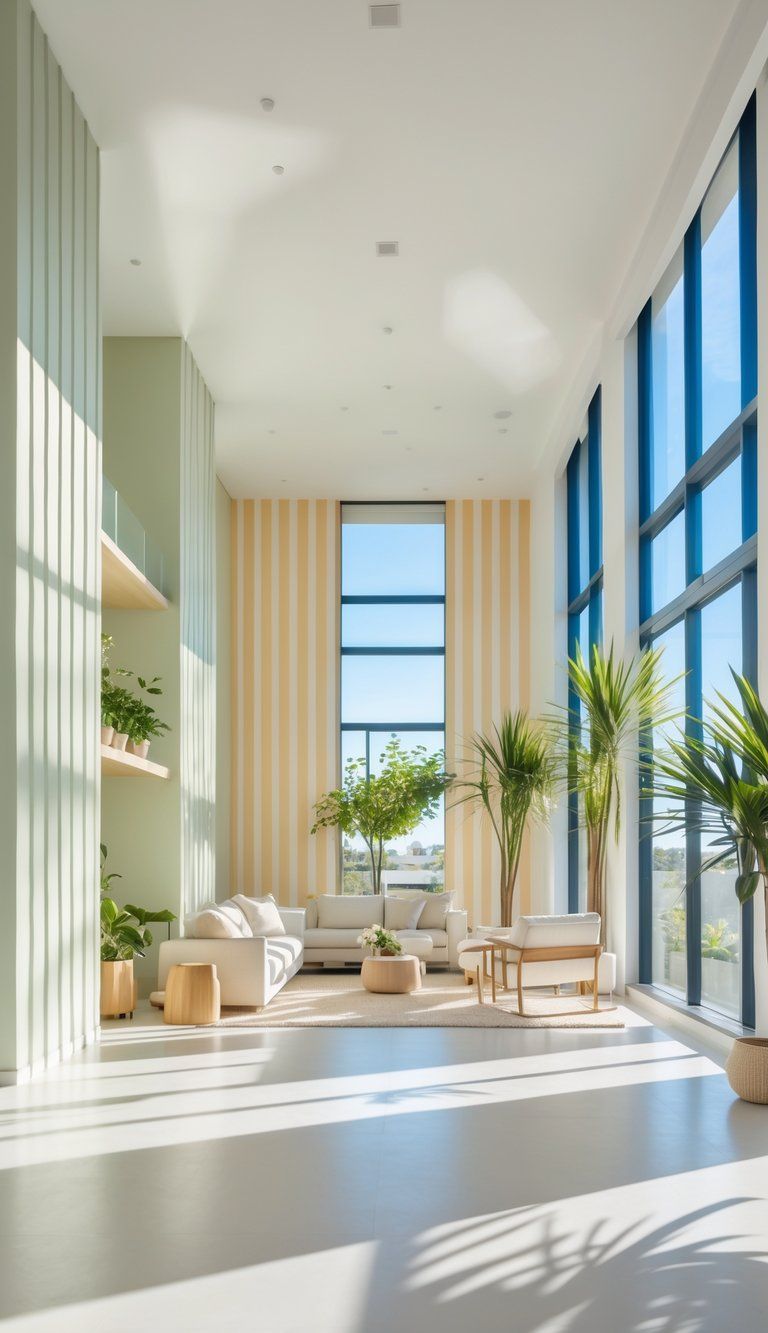
Color can totally change how tall your room feels. The right paint choices create visual tricks that make ceilings seem much higher.
Selecting Ceiling Paint and Ceiling Color
White is the classic choice, but it’s not your only option. If you paint the ceiling a shade lighter than the walls, you instantly get a sense of extra height and openness.
Glossy or semi-gloss ceiling paint bounces light around, making the ceiling look farther away.
Pale blue or soft lavender can work, too—they kind of mimic the sky, which feels limitless.
If you’re tempted by dark ceilings, think twice. In low-ceiling rooms, they usually bring the ceiling down visually. If you want some pattern, try a super subtle tone-on-tone effect to keep the eye moving up.
Choosing Wall Colors to Enhance Verticality
Vertical stripes are a lifesaver with low ceilings. They pull the eye up, making the room feel taller.
Try:
- Wallpaper with thin vertical lines
- Paint techniques for subtle stripes
- Two-tone walls, lighter on top
Keep baseboards and crown molding the same color as the walls. That way, you avoid breaking up the wall height with horizontal lines.
Cool wall colors like soft greens and blues feel open and airy. Neutral tones can work too if you want something timeless.
The Impact of Gentle Pastels and Light Colors
Light colors always make a room feel bigger and brighter. Gentle pastels and neutrals reflect more light, so everything feels airier.
Try shades like:
- Soft cream
- Pale gray
- Light sage
- Blush pink
- Subtle mint
Blending the wall and ceiling colors helps, too. If there’s no harsh line where the wall meets the ceiling, your eye just keeps going—so the ceiling feels higher.
Match your light wall colors with similarly toned furniture for a cohesive look. That way, you avoid visual clutter, which can shrink a space fast.
Vertical Patterns and Lines: Creating Height Visually
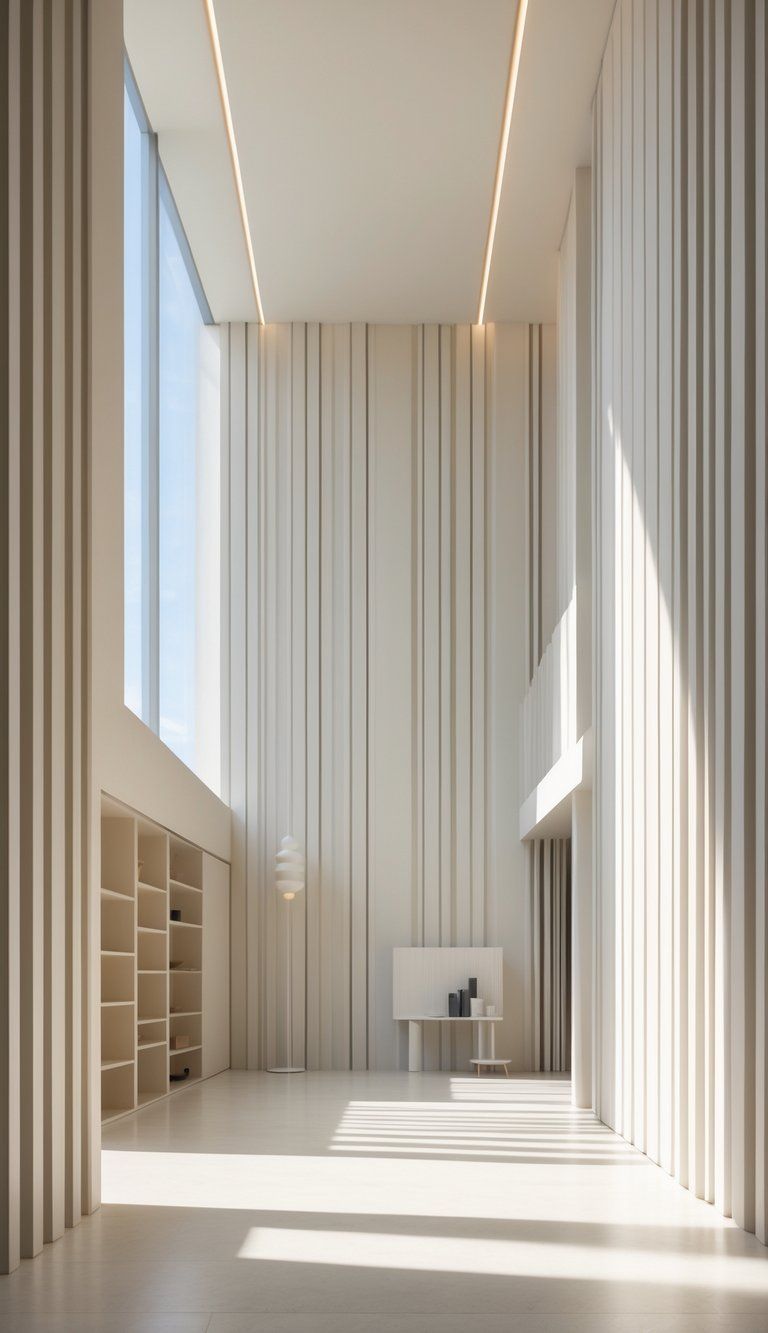
Vertical elements are your best friend in a low-ceiling room. They pull the eye up and make everything feel taller and more open.
Utilizing Vertical Stripes in Wallpaper and Decor
Striped wallpaper is a game changer. Go for thin, widely spaced vertical stripes in light colors for the best effect.
Tighter patterns can actually make an even bolder statement if that’s your thing.
You don’t have to stripe every wall. Try a striped accent wall behind your bed or sofa—it’s enough to lift the room visually.
If you want something subtler, two-tone walls with vertical paneling or board-and-batten work well. These details create shadow lines that pull the eye up without being too loud.
Avoiding Horizontal Lines and Patterns
Horizontal lines will just make the ceiling feel lower. Skip wallpaper with horizontal stripes or anything that moves the eye sideways.
Chair rails and horizontal moldings cut the wall in half. If you’re stuck with them, paint them the same color as the wall to make them disappear.
Wide, low furniture also emphasizes the shortness of the room. Pick taller, narrower pieces when you can.
Even art placement matters. Group pictures vertically instead of lining them up side by side.
Incorporating Verticality with Decor Elements
Floor-to-ceiling curtains are a secret weapon. Hang the rod near the ceiling and let the fabric hit the floor for the full effect.
Tall, narrow bookcases or shelves that reach the ceiling draw attention upward. Open shelving adds a nice airy feel, too.
Go for vertical décor—tall vases, floor lamps, or plants that grow upright. A tall floor lamp or a big leafy plant like a fiddle leaf fig works wonders.
Mount wall sconces in a vertical line to guide the eye up and add some ambient light at the same time.
Mirrors and Reflection: Maximizing Perceived Height
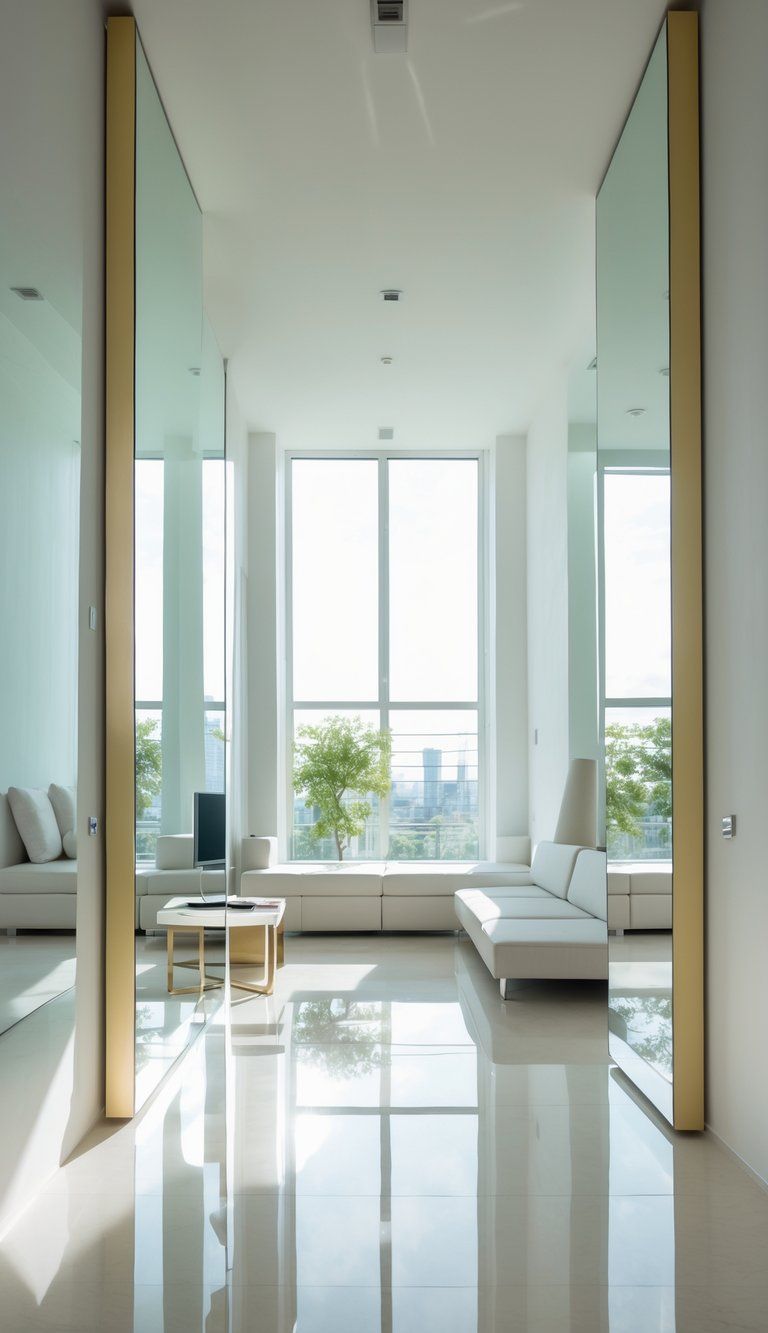
Mirrors can totally change how tall a room feels. They bounce light around and trick your brain into seeing more space than is actually there.
Using Large Mirrors to Reflect Light and Space
Large mirrors have a huge impact. Put a big mirror across from a window to bounce natural light all over the room.
This not only brightens things up but also creates the illusion of more depth and airiness.
Floor-to-ceiling mirrored panels work especially well in small rooms. They make low ceilings almost disappear by stretching the space visually.
Try putting a mirror above a console table or sofa. This draws the eye up and adds a sense of vertical space—designers use this trick all the time in living rooms and entryways to make a dramatic first impression.
Vertical Mirror Placement for Height
Where you put your mirrors matters just as much as their size. Tall, narrow mirrors play up vertical lines and pull your gaze upward.
This vertical focus helps fight the horizontal vibe of a low ceiling. Try installing several vertical mirrors in a row—honestly, it’s a cool way to create rhythm and reinforce that upward movement.
In bedrooms, a tall mirror next to the closet does double duty: it’s practical and makes the room feel taller.
If you want to get a little more dramatic, position mirrors to catch and reflect ceiling light fixtures. That move doubles your lighting’s visual punch and adds interest above eye level.
You can even angle mirrors up a bit to bounce more ceiling into view, which tricks your brain into thinking the room is taller.
Curtains, Drapes, and Window Treatments for Higher Ceilings
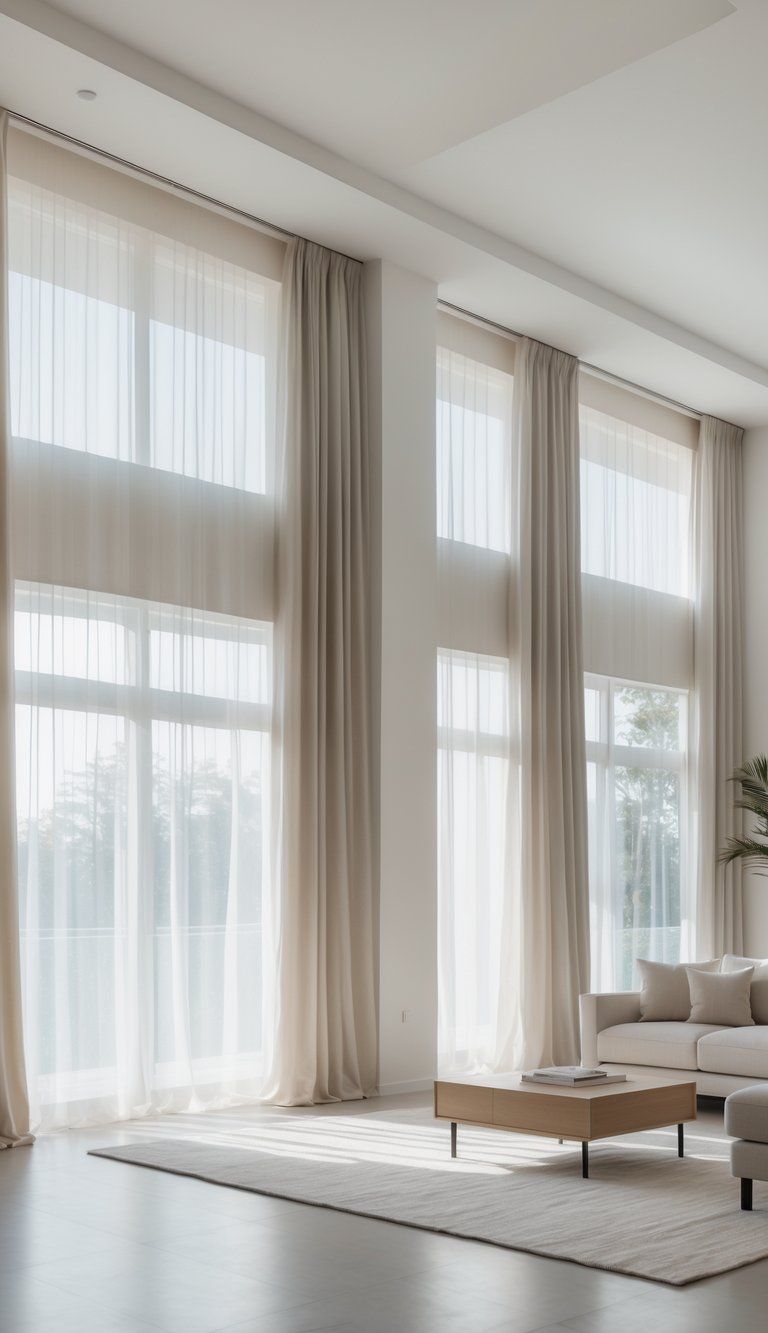
Window treatments can work magic when it comes to making a room look taller. The right curtains or drapes instantly draw eyes up and transform the vibe of your space.
Choosing Floor-to-Ceiling Curtains
Floor-to-ceiling curtains create a strong vertical line that guides your eyes up. Mount curtain rods as close to the ceiling as possible—just an inch or two below, if you can.
This trick gives you an uninterrupted visual flow from floor to ceiling. Pick fabrics that hang nicely and keep clean lines.
Linen, cotton blends, and lightweight polyester really do the job. Heavy materials that bunch up at the bottom? They just make things feel heavy and crowded.
Stick with curtain colors that match or closely blend with your wall color. That seamless look visually stretches the space.
If you’re into contrast, try vertical patterns like thin stripes—they’ll boost the height illusion.
Pro tip: Let curtains just touch the floor, but don’t let them puddle too much, or you’ll end up with a cluttered, smaller-feeling room.
Selecting Minimalist Window Coverings
Minimalist window treatments keep things simple and airy. Go for simple designs—skip the heavy valances or ornate hardware that make ceilings feel lower.
Best minimalist options:
- Roller shades that disappear when open
- Simple roman blinds mounted high above the window
- Sheer panels that filter light without adding bulk
- Slim blinds in a color matching your trim
Pick slender curtain rods in finishes that blend into your walls or ceiling. Decorative finials? Not really helpful here—they pull the eye sideways instead of up.
Light-filtering fabrics in white, cream, or pale colors bring in more daylight and keep things feeling open. Lighter options just make the ceiling seem higher, plain and simple.
Furniture Selection and Placement for Open Space
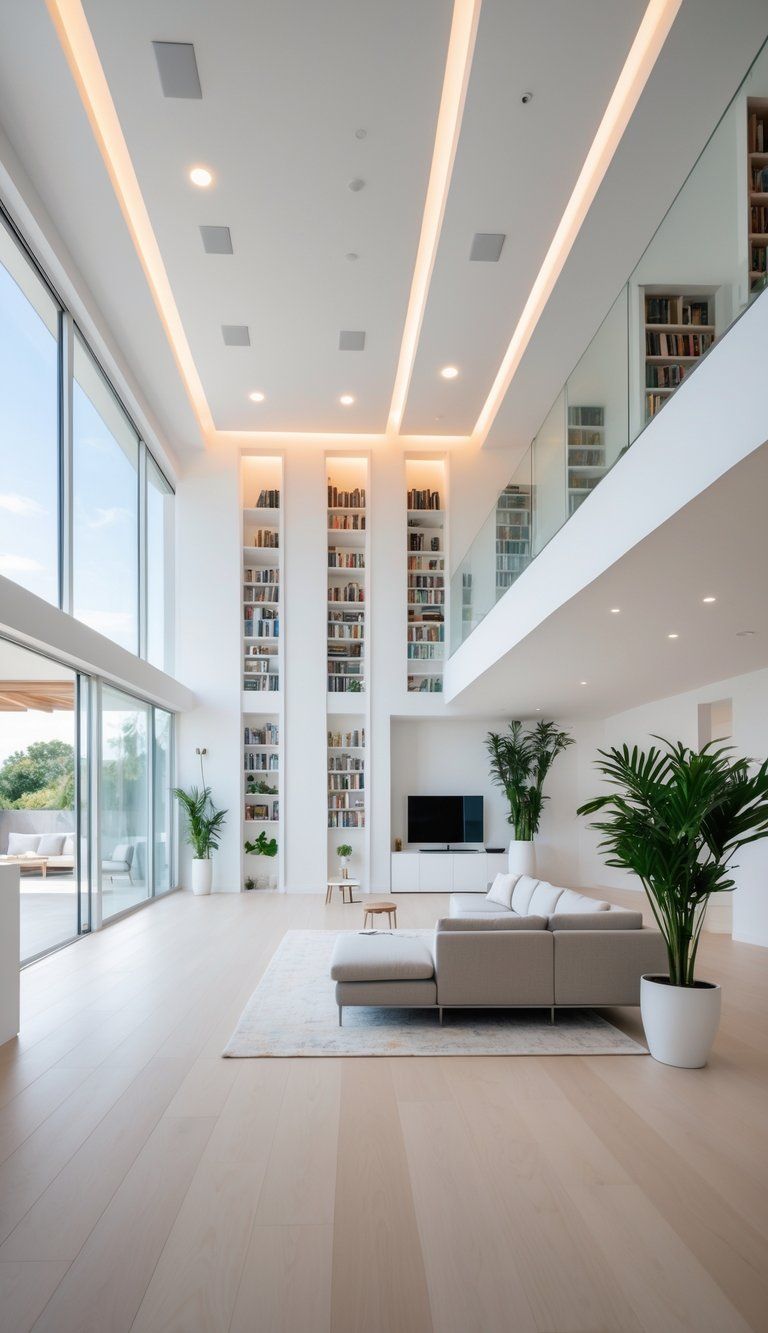
The furniture you choose—and where you put it—can totally change how high your ceilings look. Furniture acts as visual anchors that influence your sense of space.
Low-Profile Furniture to Reduce Visual Weight
Pick lower furniture to create more space between your pieces and the ceiling. A low sofa, about 16 to 18 inches off the floor, leaves more room above it.
Pieces with exposed legs work better than those that sit flat on the floor. That little bit of air underneath makes everything feel lighter.
Coffee tables should be shorter than usual—around 12 to 14 inches instead of the standard 16 to 18.
Good bets:
- Platform beds (10–12 inches high)
- Low-backed or armless chairs
- Benches instead of tall dining chairs
- Media consoles under 24 inches tall
Strategic Furniture Arrangement for Flow
Pull furniture away from the walls by a few inches. It might feel odd, but it actually makes the room look bigger and the ceiling higher.
Arrange seating in conversation groups near the center, not just against the walls. This creates natural pathways and keeps your eyes moving across the room.
Pay attention to the lines your furniture makes. Avoid lining up tall pieces all at the same height—they’ll just highlight the low ceiling.
Try these ideas:
- Float the sofa with a slim console table behind it
- Go for asymmetrical arrangements for more interest
- Use area rugs to define spaces without walls
- Put taller pieces near doorways, where ceiling height isn’t as obvious
Art and Decor Arrangements to Draw the Eye Up
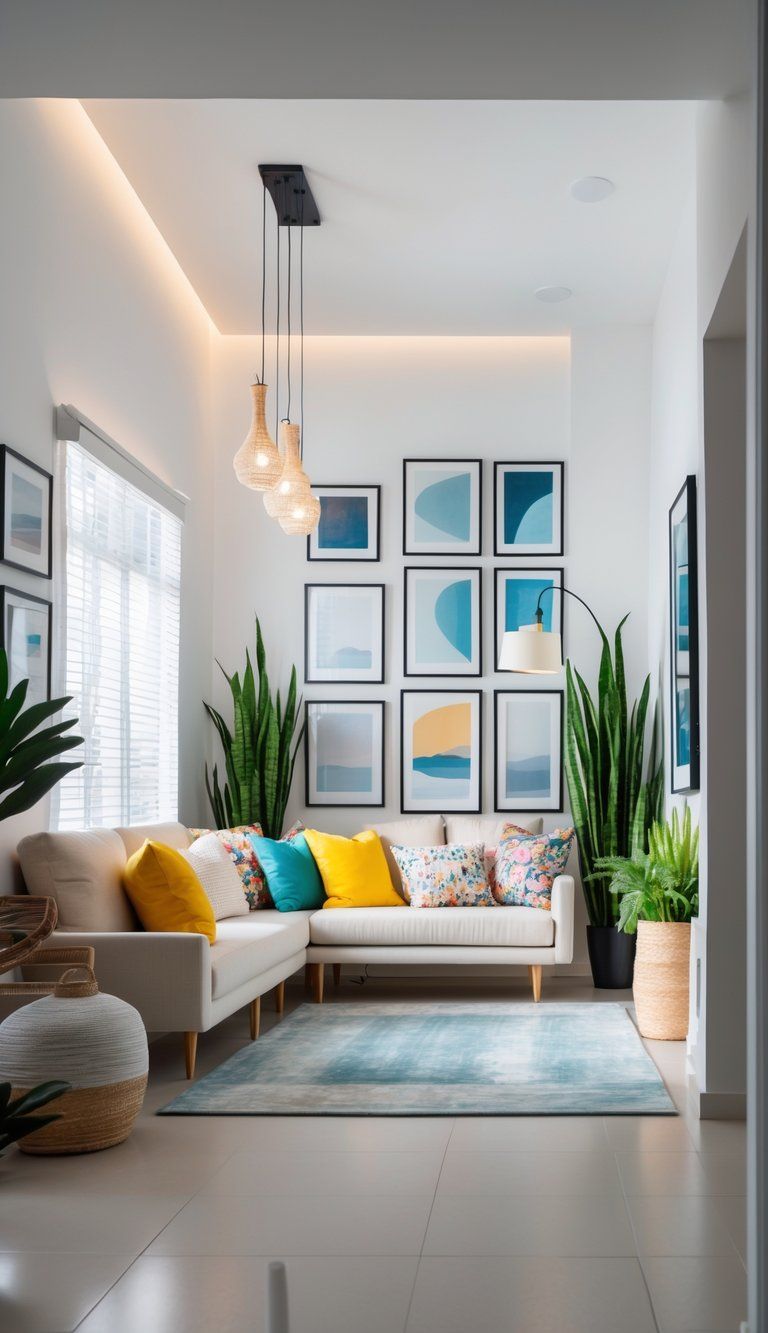
The way you hang art and arrange decor can totally change how high your ceilings feel. The right pieces and placements build visual pathways that lead your eye upward.
Vertical Artwork and Tall Decorative Elements
Hang art in vertical formats to get that upward flow. Tall, narrow paintings or photo galleries stacked vertically naturally pull attention up.
It’s a simple trick, but it really does make rooms feel taller. Try these vertical elements:
- Tall, slim bookshelves that stretch toward the ceiling
- Wall-mounted plant holders with trailing plants
- Vertical wallpaper patterns—subtle stripes work wonders
- Floor-to-ceiling curtains hung higher than the frame
When you hang several pieces, go for a vertical gallery wall that starts at eye level and climbs upward. You’ll be surprised how much height it adds.
The Role of Oversized Art as a Focal Point
One big piece of art can do more than a bunch of small ones in a room with low ceilings. An oversized canvas or print that covers a lot of wall space grabs attention and keeps people from noticing the ceiling.
Hang oversized art a little higher than usual. It forces people to look up, stretching the space visually.
For the best effect:
- Pick art with depth or perspective
- Choose pieces with upward movement
- Use lighter colors at the top of the artwork
- Add subtle lighting from above to highlight the piece
Skip cluttering your walls with lots of tiny items. One dramatic piece does the job and adds personality.
Shelving Ideas for Vertical Expansion
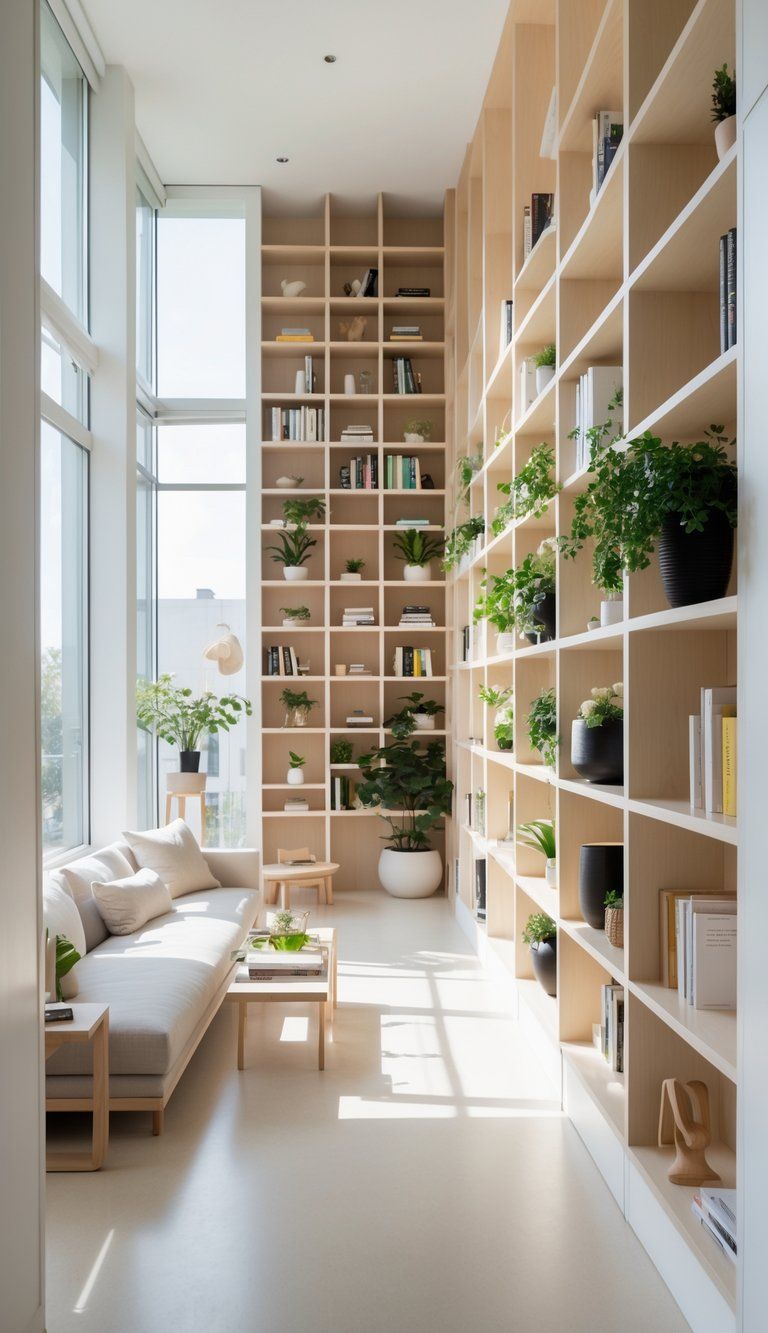
Vertical shelving is a go-to move for stretching the look of a low ceiling. The right shelves will naturally pull your gaze upward and make the space feel taller.
Installing Floor-to-Ceiling Bookshelves
Floor-to-ceiling bookshelves instantly lift the eye in a room with low ceilings. When shelves run the full height of the wall, they create strong vertical lines.
That trick makes the ceiling seem higher than it really is. Pick light-colored shelves—white or pale wood tones are especially good in small rooms.
Install these shelves on a focal wall for the biggest impact. Don’t cram them full—leave some space or mix in decorative pieces to keep things from feeling crowded.
Built-in shelves look the cleanest since they blend with your home’s architecture. If you can’t do built-ins, tall freestanding units work just as well.
Using Tall Bookcases for Vertical Storage
Tall, skinny bookcases give you storage and help stretch the space vertically. Unlike wide shelves, vertical bookcases emphasize height.
Put tall bookcases in corners or along walls where they’ll stand out the most. Units that are 7 feet or taller really do the trick.
Some solid options:
- Ladder bookcases: The tapering shape hints at more height
- Column bookcases: Tall and narrow, perfect for tight spots
- Modular systems: Adjust them to fit your ceiling
Style your shelves with bigger items on the bottom and smaller ones up high. That way, your eye travels upward naturally.
For even more height, add lighting to the top shelves. Small LEDs can spotlight the upper shelves and draw attention all the way up.
Adding Visual Interest with Ceiling Design
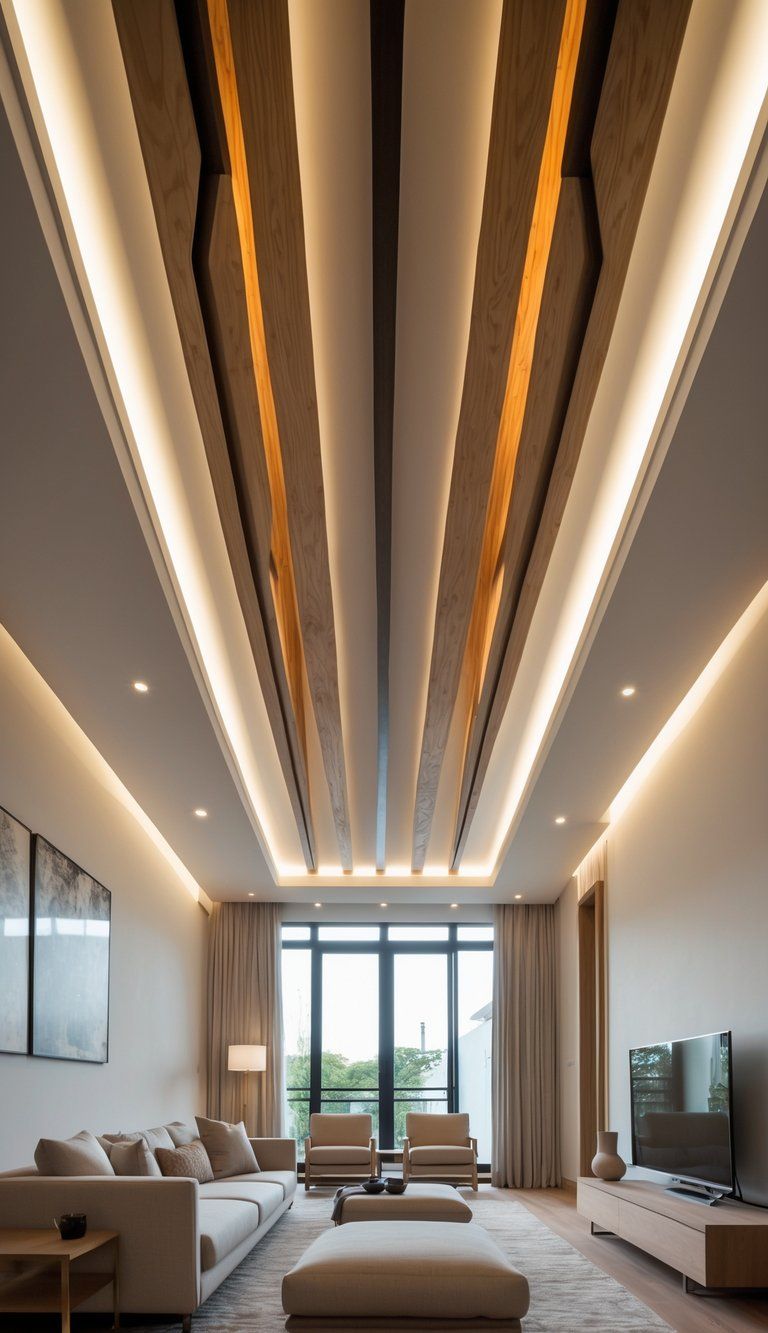
The ceiling is honestly one of the most overlooked places to add design. Smart ceiling touches can really pull the eye upward and make a low ceiling seem higher.
Selecting Subtle Crown Molding or Moulding
You don’t have to skip crown molding if your ceilings are low—just choose narrow profiles (under 3 inches). That way, you get some elegance without adding visual heaviness.
Install the molding at a steeper angle against the ceiling, not the wall, to encourage the eye to move up. Paint crown molding the same color as your ceiling for a seamless look.
This little trick blurs the line between wall and ceiling, so the room feels taller. If you want to go bolder, paint both the ceiling and the top foot or so of your walls the same color, with molding in between.
That technique pushes the ceiling boundary higher, at least visually.
Handling Exposed Beams in Low Ceiling Spaces
Exposed beams can still look great, even with low ceilings. Paint them the same color as your ceiling to keep them from standing out too much.
White or light-colored beams on a matching ceiling add texture without making the ceiling feel lower. Run beams lengthwise in the room instead of across the short side—this leads the eye along the longest direction and feels more spacious.
If your ceilings are really low, try recessing the spaces between beams and adding subtle lighting. It adds depth and makes the ceiling more interesting.
Skip dark-stained beams unless your room gets tons of natural light, because they can feel heavy and a bit oppressive overhead.
Mistakes to Avoid When Designing With Low Ceilings

Designing for low ceilings isn’t easy—some choices can accidentally make your space feel even tighter. Dodging these common mistakes can help you make the most of your room’s height.
Common Decor Pitfalls That Lower Ceilings
Hanging light fixtures too low is a big one. Pendant lights that dangle down eat up visual space and make you notice the ceiling height.
Go for flush mount or semi-flush fixtures instead. Dark ceiling paint presses down on the room, so stick with lighter shades overhead.
Tall furniture pieces like high bookcases or big entertainment centers call attention to the gap between the top and the ceiling. Use lower-profile furniture when you can.
Cluttered walls loaded with small decorations create too much visual noise. Pick one larger art piece and hang it a bit higher than usual to draw the eye up.
Heavy crown molding sets a visual border that lowers the ceiling. If you really want molding, stick to simple, smaller profiles.
Balancing Visual Interest Without Overcrowding
Skip ceiling fans with hanging chains or ornate designs that just pull your eyes down. Try to find sleek, low-profile fans that stick close to the ceiling.
Stay away from busy ceiling textures like popcorn finishes or fancy patterns. They really call attention to your ceiling’s height, and not in a good way.
Don’t crowd the space with tall vases, sculptures, or plants that just make the room feel more cramped. Go for shorter decorative pieces that won’t fight with your ceiling height.
Think twice about curtain placement. If you hang curtains at window height, it chops up the room. Mount those rods near the ceiling and let the drapes hit the floor—it’ll help draw the eye up.
Leave a little breathing room. You don’t have to fill every corner. A bit of open space makes the room feel bigger and more relaxed. Just pick your furniture and decor with intention.

